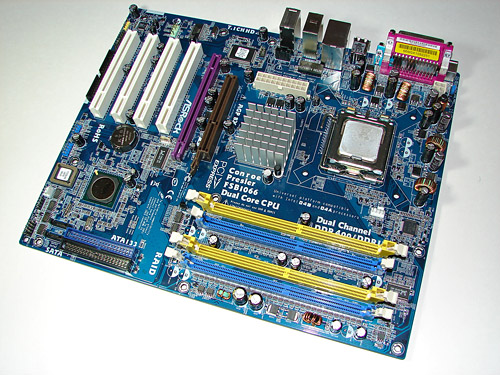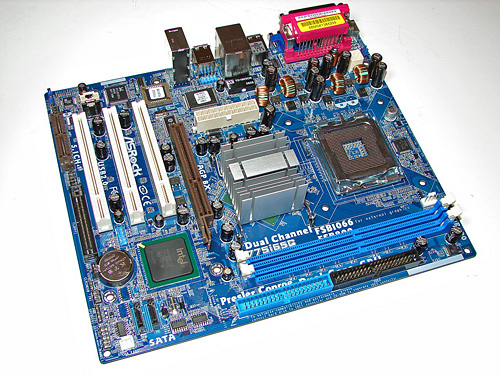ASRock Core 2 Duo: AGP/PCI Express Graphics Performance, Part Tres
by Gary Key on August 15, 2006 6:30 AM EST- Posted in
- Motherboards
System Configuration
Our memory benchmark system uses the following components:
Our test boards represent a blend of performance and pricing requirements for a value-oriented E6300 Core 2 Duo system. The choice of components is designed to provide apples to apples comparison between the PCI Express and AGP capability on our ASRock 775Dual-VSTA platform. We chose the ASRock 775i865G motherboard to provide a comparable AGP system for testing that provided DDR memory capability. We are also only reporting results with DDR memory as the typical user upgrading to either board would probably have both an AGP video card and DDR memory available for use.
Our EVGA 7600GS PCI Express or AGP video card choice represents a very good mid-range alternative and ensures you have respectable game performance at resolutions under 1280x1024 for less than $130. Our EVGA 6800 Ultra tandem represents one of the top performance cards from two years ago and should give a good indication of the performance potential of each graphics slot. Unfortunately, we were unable to procure an ATI X850XT-PE AGP card for comparison with our PCI Express version. However, we doubt there would have been any additional information gained about AGP/PCI-E performance when testing the ATI solutions.
Our feature motherboard is the ASRock 775Dual-VSTA that includes the VIA PT880 Pro Northbridge and VT8237A Southbridge which fully support Core 2 Duo with the proper VRM and BIOS support. The ASRock 775Dual-VSTA is a very unusual board considering all of the available upgrade options and is available at a low entry price of $55.
The board is laid out nicely and certainly caters to those who value IDE and PCI devices. The VT8237A only supports two SATA 1.5Gbps drives but does support four IDE devices. This board also features both AGP 8X capability, PCI-E graphics ability at X4 operation, VIA 10/100 Ethernet LAN, and Realtek ALC-888 HD 7.1 audio. The overall feature set of the VIA chipset is the same as the Biostar PT880 Pro board we reviewed a few months back.
Our other ASRock motherboard is the 775i65G based upon the Intel 865G Northbridge and ICH5 Southbridge with board updates that allow full support for the Core 2 Duo processor series. This motherboard also features on-board graphics capability but requires an external AGP card in order to support the 1066FSB requirement of the Core 2 Duo.
The motherboard utilizes a micro ATX form factor and includes three PCI slots, one AGP 8X slot, one AMR slot, Realtek 10/100 Ethernet LAN, and C-Media 9761a 5.1 Channel audio. The layout is very good and the board is clearly designed for users who want to continue using their AGP video card and DDR memory while upgrading to a newer processor. This motherboard should retail for around US $50 and requires a revision 2 layout for Core 2 Duo compatibility.
Our memory benchmark system uses the following components:
| Performance Test Configuration | |
| Processor: | Intel Core 2 Duo E6300 (Dual core 1.86GHz 2MB Unified Cache) |
| RAM: | 2 x 512MB Patriot DDR-400 (1GB Kit - 2x512 MB) |
| Hard Drive: | Seagate 320GB 7200.10 (16MB Buffer) |
| System Platform Drivers: | VIA 5.09a Intel 8.0.1.1002 |
| Video Cards: | 1 x EVGA 7600GS PCI-E - PCI-E Tests 1 x EVGA 7600GS AGP - AGP Tests 1 x EVGA 6800 Ultra PCI-E - PCI-E Tests 1 x EVGA 6800 Ultra AGP - AGP Tests |
| Video Drivers: | NVIDIA 91.31 |
| CPU Cooling: | Stock Intel Heatsink |
| Power Supply: | OCZ PowerStream 520W |
| Motherboards: | ASRock 775Dual-VSTA (VIA PT880Pro) ASRock 775i865G (Intel 865G) |
| Operating System: | Windows XP Professional SP2 |
| BIOS: | AMI 1.50 - ASRock 775Dual-VSTA AMI 2.50 - ASRock 775i65G |
Our test boards represent a blend of performance and pricing requirements for a value-oriented E6300 Core 2 Duo system. The choice of components is designed to provide apples to apples comparison between the PCI Express and AGP capability on our ASRock 775Dual-VSTA platform. We chose the ASRock 775i865G motherboard to provide a comparable AGP system for testing that provided DDR memory capability. We are also only reporting results with DDR memory as the typical user upgrading to either board would probably have both an AGP video card and DDR memory available for use.
Our EVGA 7600GS PCI Express or AGP video card choice represents a very good mid-range alternative and ensures you have respectable game performance at resolutions under 1280x1024 for less than $130. Our EVGA 6800 Ultra tandem represents one of the top performance cards from two years ago and should give a good indication of the performance potential of each graphics slot. Unfortunately, we were unable to procure an ATI X850XT-PE AGP card for comparison with our PCI Express version. However, we doubt there would have been any additional information gained about AGP/PCI-E performance when testing the ATI solutions.
Our feature motherboard is the ASRock 775Dual-VSTA that includes the VIA PT880 Pro Northbridge and VT8237A Southbridge which fully support Core 2 Duo with the proper VRM and BIOS support. The ASRock 775Dual-VSTA is a very unusual board considering all of the available upgrade options and is available at a low entry price of $55.
 |
| Click to enlarge |
The board is laid out nicely and certainly caters to those who value IDE and PCI devices. The VT8237A only supports two SATA 1.5Gbps drives but does support four IDE devices. This board also features both AGP 8X capability, PCI-E graphics ability at X4 operation, VIA 10/100 Ethernet LAN, and Realtek ALC-888 HD 7.1 audio. The overall feature set of the VIA chipset is the same as the Biostar PT880 Pro board we reviewed a few months back.
Our other ASRock motherboard is the 775i65G based upon the Intel 865G Northbridge and ICH5 Southbridge with board updates that allow full support for the Core 2 Duo processor series. This motherboard also features on-board graphics capability but requires an external AGP card in order to support the 1066FSB requirement of the Core 2 Duo.
 |
| Click to enlarge |
The motherboard utilizes a micro ATX form factor and includes three PCI slots, one AGP 8X slot, one AMR slot, Realtek 10/100 Ethernet LAN, and C-Media 9761a 5.1 Channel audio. The layout is very good and the board is clearly designed for users who want to continue using their AGP video card and DDR memory while upgrading to a newer processor. This motherboard should retail for around US $50 and requires a revision 2 layout for Core 2 Duo compatibility.










43 Comments
View All Comments
atlr - Thursday, January 25, 2007 - link
Has anyone compared the performance of agp and pci-e versions of the x1950pro on the Asrock Dual-VSTA?I am wondering if the 4x PCI-E on the Asrock will be a noticeable bottleneck with a GPU faster than the 6800Ultra.
mongo lloyd - Tuesday, August 22, 2006 - link
Does anyone know of a board similar to the i865PE-based Asrock board, released or upcoming, that basically has the same features only with gigabit LAN? Intel CSA preferred, but even gigabit hanging off the PCI bus would be better than the 10/100 crap. It's a must for me, and such a board would make an upgrade really desirable.hibachirat - Tuesday, August 22, 2006 - link
I think you'll have a hard time finding an AGP & DDR intel Conroe supporting mobo with built-in gigabit LAN. mATX too? No hope, but you could get one of these and then add an ethernet card like we used to do in times of yore.Sc4freak - Saturday, August 19, 2006 - link
"Three" in French is "trois". "Tres" means "very"."ASRock Core 2 Duo: AGP/PCI Express Graphics Performance, Part Very" :p
Un, deux, trois, quatre, cinq, six, sept, huit, neuf, dix.
Gary Key - Sunday, August 20, 2006 - link
I know French, Tres is three in Spanish and hence the change up for our Spanish speaking friends. :)
lapierrem - Thursday, August 17, 2006 - link
I find it very amusing to see that AGP cards can still beat a PCI-e card which is supposed to be so much faster and better in many respects, but apparently isn't. I know on the other Asrock boards, like the 939DualSata2 the AGP is bridged off the PCI-E bus and is supposed to be slower, but wow. Maybe if we had gone with dual AGP cards for SLI we woulda had the real dealCrappyLuckMan - Thursday, August 17, 2006 - link
Anandtrash buys ascrock stock and bans me. Yey no more n00bs.CrappyLuckMan - Wednesday, August 16, 2006 - link
In all the asrock tests it's the Asrock that's a bottleneck. I believe the best way to bench is use a card that comes in both flavors and run it on an NF4 w/AM2 DDR-2 and one in an NF4 agp mobo with DDR. You test ram and video card this way at the same time on the same chipset and same cpu with same cache and same speed. Only difference is one is ddr-2 and has an extra pin.And from my experience with Asrock boards is that they die for no reason and wont boot no matter what you do after a while. You get what you pay for and I can't believe how much attention you are giving this cheapo mobo.
hibachirat - Friday, August 18, 2006 - link
Too bad your experience was negative, but I have had top of the line ASUS and AOPEN boards that were junk fresh out of the box. And problematic top of the line boards from MSI and Abit. Also had great boards from the same makers. Now I'm running some "cheap" boards from Asrock and Biostar that are rock solid. The difference between the high end and low end boards has more to do with cutting edge feature sets and fractional performance gains than it does with stability and longevity. Asrock may be soft-rock to the T-O-L boards heavy metal, but that suits some of us just fine.CrappyLuckMan - Saturday, August 19, 2006 - link
Well then again I see on newegg a lot of people use junk ram and or crappy psu's and call the mobo junk cause it doesn't post. Even if the asrock posts and doesn't die in a year, I still think it is a bottleneck and it shouldn't be used to compare agp vs pci x16.